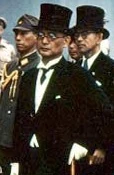
Mamoru Shigemitsu (29 July 1887 – 26 January 1957) was Minister of Foreign Affairs of Japan from 20 April 1943 to 22 July 1944 (succeeding Masayuki Tani and preceding Kantaro Suzuki) and from 17 August 1945 to 15 September 1945 (succeeding Shigenori Togo and preceding Shigeru Yoshida), as well as Deputy Prime Minister from 10 December 1954 to 23 December 1956, succeeding Taketora Ogata and preceding Mitsujiro Ishii.
Biography[]
Mamoru Shigemitsu was born in Bungo-ono, Oita Prefecture, Japan on 29 July 1887, and he graduated from the law school of Tokyo Imperial University in 1907. He served as a diplomat in Germany, the United Kingdom, and the United States after World War I, and he also brokered a ceasefire between the Imperial Japanese Army and the Kuomintang after a skirmish at Shanghai in 1932. He was wounded when Korean independence activist Yoon Bong-gil threw a bomb at Emperor Hirohito, killing General Yoshinori Shirakawa instead. He served as ambassador to the Soviet Union and Britain in the early years of World War II, and his attempts to stave off World War II angered the militarists in the Japanese government. In 1943, Hideki Tojo fired Masayuki Tani as Foreign Minister and appointed Shigemitsu to the post, anticipating the defeat of the Axis Powers during the war. On 2 September 1945, while serving as civilian plenipotentiary, he signed the Japanese instrument of surrender aboard USS Missouri (BB-63). Despite his opposition to the war and protests by US ambassador Joseph Grew and even the chief prosecutor Joseph B. Keenan, Shigemitsu was sentenced to seven years in prison at Sugamo Prison for war crimes, but he was paroled in 1950. He was elected to the Diet of Japan as a member of the Liberal Democratic Party of Japan member, and he served as Foreign Minister from 1954 to 1956, also serving as Deputy Prime Minister. He died of angina in 1957 at the age of 69.
